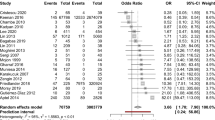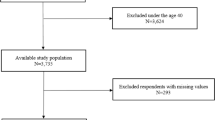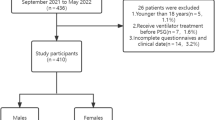Abstract
Background
To assess the association between patients with normal tension glaucoma (NTG) and the risk of obstructive sleep apnoea (OSA) using the STOP-Bang questionnaire.
Methods
A population-based cross-sectional analysis was performed using data from the Korean National Health and Nutrition Examination Survey from 2019 to 2021. An overall of 8832 subjects ≥ 40 years of age were investigated. Patients with NTG and controls completed the STOP-Bang questionnaire, a validated tool for identifying high-risk patients for OSA. The patients were divided into low-, intermediate-, and high-risk groups based on their scores.
Results
The mean STOP-Bang scores were 2.04 ± 0.02 in the control group and 2.42 ± 0.10 in the NTG group, with significant differences between groups (p < 0.001). In univariate logistic regression models, both intermediate-risk (Odds ratio (OR), 1.42; 95% Confidence intervals (CI), 1.05–1.91) and high-risk (OR, 1.71; 95% CI, 1.22–2.40) for OSA groups revealed a significant relationship regarding NTG compared to low-risk for OSA group. When adjusted for all confounding factors, the high risk for the OSA group was significantly associated with NTG (OR, 1.54; 95% CI, 1.06–2.24).
Conclusions
Our results indicate that high-risk OSA, as measured using the STOP-Bang questionnaire, correlates with NTG. Therefore, patients who scored two or more on the STOP-Bang questionnaire and were male, had a BMI > 35 or a neck circumference > 40 cm, or those who scored five or more and were classified as high risk should be carefully monitored because of the significantly higher likelihood of an association with NTG.
This is a preview of subscription content, access via your institution
Access options
Subscribe to this journal
Receive 18 print issues and online access
$259.00 per year
only $14.39 per issue
Buy this article
- Purchase on SpringerLink
- Instant access to full article PDF
Prices may be subject to local taxes which are calculated during checkout


Similar content being viewed by others
Data availability
The data used in this study are accessible to the public through the KNHANES website. (https://knhanes.kdca.go.kr/knhanes/eng/main.do, accessed on 15 June 2024).
References
Flammer J, Orgul S, Costa VP, Orzalesi N, Krieglstein GK, Serra LM, et al. The impact of ocular blood flow in glaucoma. Prog Retin Eye Res. 2002;21:359–93.
Benjafield AV, Ayas NT, Eastwood PR, Heinzer R, Ip MSM, Morrell MJ, et al. Estimation of the global prevalence and burden of obstructive sleep apnoea: a literature-based analysis. Lancet Respir Med. 2019;7:687–98.
Jyothi I, Prasad KR, Rajalakshmi R, Kumar RCS, Talatam R, Vijayakumar TM, et al. Obstructive Sleep Apnea: A Pathophysiology and Pharmacotherapy Approach. In: Mayank V, editor. Noninvasive Ventilation in Medicine. Rijeka: IntechOpen; 2019.
Cheong AJY, Wang SKX, Woon CY, Yap KH, Ng KJY, Xu FWX, et al. Obstructive sleep apnoea and glaucoma: a systematic review and meta-analysis. Eye. 2023;37:3065–83.
Chaitanya A, Pai VH, Mohapatra AK, Ve RS. Glaucoma and its association with obstructive sleep apnea: A narrative review. Oman J Ophthalmol. 2016;9:125–34.
Young T, Evans L, Finn L, Palta M. Estimation of the clinically diagnosed proportion of sleep apnea syndrome in middle-aged men and women. Sleep. 1997;20:705–6.
Chung F, Yegneswaran B, Liao P, Chung SA, Vairavanathan S, Islam S, et al. STOP questionnaire: a tool to screen patients for obstructive sleep apnea. Anesthesiology. 2008;108:812–21.
Chung F, Abdullah HR, Liao P. STOP-Bang questionnaire: a practical approach to screen for obstructive sleep apnea. Chest. 2016;149:631–8.
Yoon KC, Choi W, Lee HS, Kim S-D, Kim S-H, Kim CY, et al. An overview of ophthalmologic survey methodology in the 2008–2015 Korean National Health and Nutrition Examination Surveys. Korean J Ophthalmol. 2015;29:359–67.
Kweon S, Kim Y, Jang MJ, Kim Y, Kim K, Choi S, et al. Data resource profile: the Korea National Health and Nutrition Examination Survey (KNHANES). Int J Epidemiol. 2014;43:69–77.
Lee JH, Kwon YJ, Kim SJ, Joung B. Metabolic syndrome as an independent risk factor for glaucoma: a nationally representative study. Diabetol Metab Syndr. 2023;15:177.
Song SJ, Choi KS, Han JC, Jee D, Jeoung JW, Jo YJ, et al. Methodology and Rationale for Ophthalmic Examinations in the Seventh and Eighth Korean National Health and Nutrition Examination Surveys (2017–2021). Korean J Ophthalmol. 2021;35:295–303.
Foster PJ, Buhrmann R, Quigley HA, Johnson GJ. The definition and classification of glaucoma in prevalence surveys. Br J Ophthalmol. 2002;86:238–42.
Nagappa M, Liao P, Wong J, Auckley D, Ramachandran SK, Memtsoudis S, et al. Validation of the STOP-Bang questionnaire as a screening tool for obstructive sleep apnea among different populations: a systematic review and meta-analysis. PLoS ONE. 2015;10:e0143697.
Chung F, Yang Y, Brown R, Liao P. Alternative scoring models of STOP-Bang questionnaire improve specificity to detect undiagnosed obstructive sleep apnea. J Clin Sleep Med. 2014;10:951–8.
Nagappa M, Wong J, Singh M, Wong DT, Chung F. An update on the various practical applications of the STOP-Bang questionnaire in anesthesia, surgery, and perioperative medicine. Curr Opin Anaesthesiol. 2017;30:118–25.
Hedner J. Vascular function in OSA. Sleep. 1996;19:S213–7.
Sergi M, Salerno DE, Rizzi M, Blini M, Andreoli A, Messenio D, et al. Prevalence of normal tension glaucoma in obstructive sleep apnea syndrome patients. J Glaucoma. 2007;16:42–6.
Kargi SH, Altin R, Koksal M, Kart L, Cinar F, Ugurbas SH, et al. Retinal nerve fibre layer measurements are reduced in patients with obstructive sleep apnoea syndrome. Eye. 2005;19:575–9.
Kremmer S, Niederdräing N, Ayertey HD, Steuhl KP, Selbach JM. Obstructive sleep apnea syndrome, normal-tension glaucoma, and nCPAP therapy-a short note. Sleep. 2003;26:161–2.
Mojon DS, Hess CW, Goldblum D, Fleischhauer J, Koerner F, Bassetti C, et al. High prevalence of glaucoma in patients with sleep apnea syndrome. Ophthalmology. 1999;106:1009–12.
Geyer O, Cohen N, Segev E, Rath EZ, Melamud L, Peled R, et al. The prevalence of glaucoma in patients with sleep apnea syndrome: same as in the general population. Am J Ophthalmol. 2003;136:1093–6.
Lin PW, Friedman M, Lin HC, Chang HW, Wilson M, Lin MC. Normal tension glaucoma in patients with obstructive sleep apnea/hypopnea syndrome. J Glaucoma. 2011;20:553–8.
Cabrera M, Benavides AM, Hallaji NAE, Chung SA, Shapiro CM, Trope GE, et al. Risk of obstructive sleep apnea in open-angle glaucoma versus controls using the STOP-Bang questionnaire. Can J Ophthalmol. 2018;53:76–80.
Mehta A, Man REK, Gan AT, Najjar RP, Nongpiur M, Lamoureux EL, et al. Association between risk of obstructive sleep apnea and glaucoma: the Singapore epidemiology of eye diseases study. J Glaucoma. 2022;31:935–40.
Blumen Ohana E, Blumen MB, Bluwol E, Derri M, Chabolle F, Nordmann JP. Primary open-angle glaucoma and snoring: prevalence of OSAS. Eur Ann Otorhinolaryngol Head Neck Dis. 2010;127:159–64.
Chuang LH, Koh YY, Chen HSL, Lo YL, Yu CC, Yeung L, et al. Normal tension glaucoma in obstructive sleep apnea syndrome: a structural and functional study. Medicine. 2020;99:e19468.
Sponsel WE, Arango S, Trigo Y, Mensah J. Clinical classification of glaucomatous visual field loss by frequency doubling perimetry. Am J Ophthalmol. 1998;125:830–6.
Delgado MF, Nguyen NT, Cox TA, Singh K, Lee DA, Dueker DK, et al. Automated perimetry: a report by the American Academy of Ophthalmology. Ophthalmology. 2002;109:2362–74.
Paczka JA, Friedman DS, Quigley HA, Barron Y, Vitale S. Diagnostic capabilities of frequency-doubling technology, scanning laser polarimetry, and nerve fiber layer photographs to distinguish glaucomatous damage. Am J Ophthalmol. 2001;131:188–97.
Acknowledgements
This work was supported by the National Research Foundation of Korea (NRF) grant funded by the Korea government (MSIT) (No. 2022R1F1A107625911).
Author information
Authors and Affiliations
Contributions
EJK performed the study design, data interpretation, and analysis and wrote the manuscript. JSL and CYK contributed to the data interpretation. HWB was responsible for the supervision, study design, analysis, and manuscript writing.
Corresponding author
Ethics declarations
Competing interests
The authors declare no competing interests.
Additional information
Publisher’s note Springer Nature remains neutral with regard to jurisdictional claims in published maps and institutional affiliations.
Rights and permissions
Springer Nature or its licensor (e.g. a society or other partner) holds exclusive rights to this article under a publishing agreement with the author(s) or other rightsholder(s); author self-archiving of the accepted manuscript version of this article is solely governed by the terms of such publishing agreement and applicable law.
About this article
Cite this article
Koh, E.J., Lee, J.S., Kim, C.Y. et al. Association between normal tension glaucoma and the risk of obstructive sleep apnoea using the STOP-Bang questionnaire. Eye 39, 1420–1425 (2025). https://doi.org/10.1038/s41433-025-03638-z
Received:
Revised:
Accepted:
Published:
Issue date:
DOI: https://doi.org/10.1038/s41433-025-03638-z



